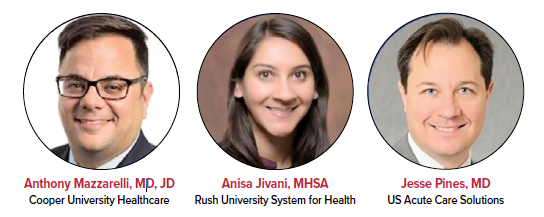Emergency physicians treat everyone, regardless of social position, race, ethnicity, gender, religion, sexual identity, or abilities. However, are we treating everyone equally?
No matter how mission-driven we are, we cannot effectively and sustainably address the social determinants of health without ensuring the financial viability of the healthcare system. EMRA’s Social EM Committee partnered with the Administration and Operations Committee to host an “Intersection of Administration and Health Equity” panel discussion to focus on the crucial role that leaders and administrators play in addressing disparities within the emergency department and hospital system. This recap of that conversation is intended to stimulate discussions on equity and help us identify opportunities for improvement in our own emergency departments.
Meet the Experts
The health equity experts who joined for the panel included:
- Anisa Jivani, MHSA, Rush University System for Health
- Jesse Pines, MD, MBA, FACEP, US Acute Care Solutions
- Anthony Mazzarelli, MD, JD, MBE, Cooper University Healthcare
Creating a Culture
Dr. Pines expressed optimism that many organizations are focusing more on health equity, highlighting efforts of employee recruitment and the establishment of Chief Equity Officers at many institutions. Dr. Mazzarelli emphasized the importance of culture for addressing health equity issues, noting “culture eats strategy.” He encourages emergency physicians to think about how reducing disparities can be incorporated into everyday work. He used the example of how social workers and community health workers are often available throughout the week but might be less available on weekends or overnight shifts. In many EDs, there may be a cultural norm of not wanting to bother social experts while on call or otherwise less available; however, what if it became the norm to activate those resources when needed? This could help connect even more patients to vital community resources, regardless of the day of the week.
Managing the Business Side
Ms. Jivani addressed the impacts of the business model of healthcare. It is important to keep in mind the financial drivers while attempting to create long-term solutions for health equity. Often, patients seen in the ED could have been better cared for with augmented primary care resources. By focusing on initiatives that improve long-term outcomes and ultimately reduce costs, it can be easier to propose new ideas for health equity from an administration standpoint. Dr. Pines discussed how the private sector in EM is also becoming increasingly incentivized to advance health equity in the setting of a more favorable political and resource landscape. Dr. Mazzarelli discussed how every administrator has a role to play in diversity and equity. If each of us consistently thinks about these issues and incorporates them into daily work, it will not only drive the system’s culture but also create an environment that fosters new health equity initiatives.
Collecting the Data
Dr. Mazzarelli shared how everyone must be willing to look for disparities. Ms. Jivani mentioned that most medical record systems have the ability to filter data based on social determinants of health. Training physicians and empowering them to collect their own data can be a great start. Dr. Mazzarelli suggested looking at current research on disparities within a specialty and starting to look for that data in our own departments. Dr. Pines stressed the importance of making this data usable for clinicians via the creation of dashboards, and creating an appropriate context for patient care to drive home the “why” of social equity in the ED.
Finding the Solution
Once your ED collects more data, Dr. Mazzarelli suggested protocolization of patient care interventions. He cited, as an example, pain management protocols for long bone fractures, aimed at addressing disparities in analgesic dosing and time to administration. Ms. Jivani discussed how the same methodology for other quality improvement initiatives also applies to health equity interventions such as Plan-Do-Study-Act. These interventions require a multi-disciplinary approach, including clinical practice along with community engagement and education. It is also important to put effort into training students with a health equity curriculum to establish long-term effects.
Looking Forward
Without a doubt, the COVID-19 pandemic has greatly impacted initiatives for health equity. Ms. Jivani highlighted how COVID drew attention to health disparities, which led to people being more willing to innovate. This greatly sped up change in medicine, making people realize initiatives such as telehealth do not take as long to implement as previously thought. She also noted this opened the door more for collaboration with community leaders and public health officials.
Conversely, the panel also noted that pandemic-related financial constraints and staffing shortages have strained staff to take on additional work of addressing health equity. The panelists were encouraged, however, because they felt that most healthcare workers are mission-driven and want to be part of something bigger than themselves. Dr. Mazzarelli cited the increase of state and federal funding for innovative solutions to addressing health equity, leading to more effective community COVID testing and vaccinations.
Final Thoughts
The panel discussion concluded with advice on incorporating health equity over the course of a career. Ms. Jivani urged medical students and residents to be open to changes and lead change when they see gaps. Dr. Pines reinforced that EM trainees have the skills and perspective to effect meaningful change. Dr. Mazzarelli encouraged each of us to show intentionality with our actions, to put our passions at the forefront, and to create a culture of positive change.
The panel highlighted the position emergency physicians are in to witness disparities and novel ways for us to combat them. It is our duty to find interventions that improve health equity for our communities, and then bring this mindset to the rest of medicine.



